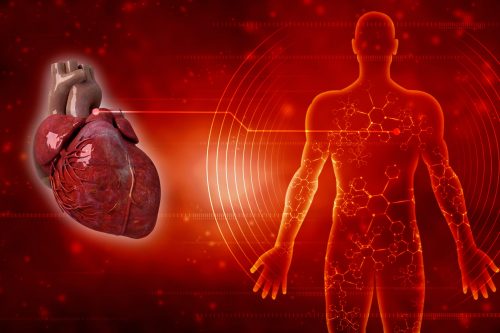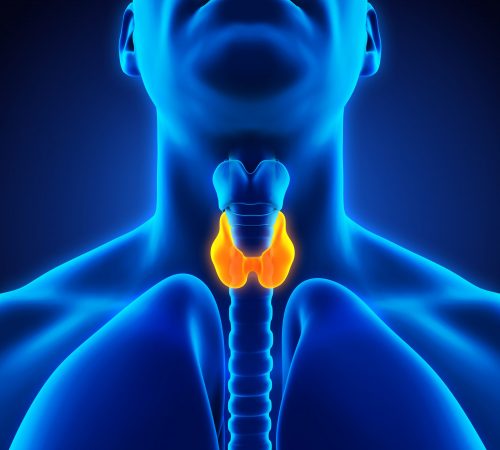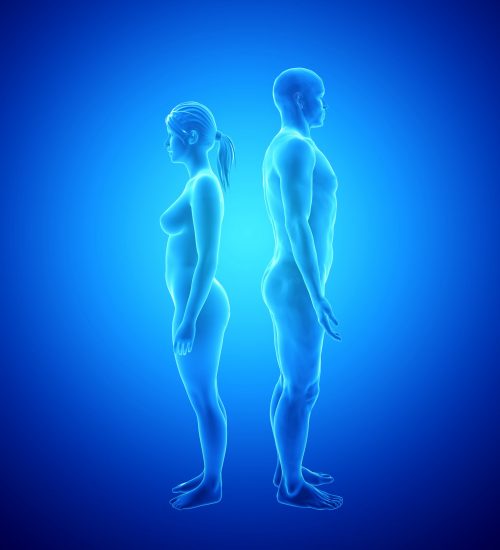Dispelling The Myths: TRT & Cardiovascular Health

The Greek philosopher Aristotle was the first known person to identify the heart as the most important organ in the body, according to his observations of chick embryo development. He referred to the heart as the seat of intelligence, motion, and sensation. Over time, our understanding of the heart has grown immensely. The heart is indeed incredibly important and can be quite difficult to replace without some lasting complications. It is a part of your cardiovascular system (CVS).
In the simplest of terms, the CVS is comprised of the heart, blood vessels, and blood itself. Your heart acts as the system’s pump, where the blood vessels merely act to ensure that the blood is transported throughout the system. Your blood could be described as the fluid that effectively carries oxygen, nutrients, and more around the body. It also serves to carry waste products away to be removed.
Cardiovascular diseases (CVDs) are the leading cause of death worldwide; more people die from CVD than any other cause 1. The bleak figures are an estimated 17.9 million deaths in 2016, which represented 31% of all global deaths; 85% of these were specifically due to heart attack and stroke 1. The symptoms of CVD tend to be insidious and chronic in nature, creeping up until a complication occurs, such as a heart attack. A healthier CVS will generally promote better overall health and wellbeing, though your primary motivator should be to not die from CVD.
CVDs include a range of diseases, some involving the blood vessels (called vascular diseases), including:
- Coronary Artery Diseases (CAD)
i.e. angina (chest pain/pressure due to lack of blood flow to the heart), heart attacks etc.
- Peripheral Arterial Diseases
Affecting blood vessels which supply blood to the arms & legs.
- Aortic Aneurysm
Enlargement of the aorta which can lead to rupture causing massive internal bleeding, which can lead to shock & death.
- Cerebrovascular Disease
Affecting the blood vessels which supply blood to the brain, which can cause strokes.
In addition to CVDs that primarily involve the heart:
- Cardiomyopathy
A group of diseases which affect the heart muscle.
- Hypertensive Heart Disease
Heart diseases which affect the heart secondary to high blood pressure.
- Heart Failure
Inability of the heart to supply adequate blood to its tissue to meet its needs.
- Pulmonary Heart Disease
Failure at the right side of the heart with respiratory system involvement (generally due to enlargement of the right ventricle of the heart due to increased blood pressure at the lungs).
This is a non-exhaustive list. There are other CVDs. A health CVS means reducing the risk of these diseases, and being fitter in general means that you are more likely to have greater psychological well-being, better erections, feeling more energetic and living longer while being fitter. The risk factors are also well understood and some easily modifiable. They include the following:
- Genetics
Several mutations have been identified which can increase the risk of CVDs 2. There’s also strong epidemiologic evidence for a familial risk; having at least one parent that had CVD can double the 8-year risk of getting CVD among men and increase the risk in women by 70%, as shown in the Framingham study 3. That’s not an excuse to give up, it’s a reason to minimise your risk further.
- Age
It’s debateable that age is the most important factor. Your risk of CVD can triple with each decade of life 4. There is not a great deal you can do about getting older, however you can reduce your risk through other means.
- Biological Sex
Men generally are at greater risk than women to have CVD in later life. Though if a woman has diabetes, she is more likely to develop heart disease than a man with diabetes.
- Tobacco
Around 10% of CVD can be attributed to smoking 5, including exposure from second-hand smoke. But if you quit smoking by age 30, your risk of death can be almost as low as never-smokers 6.
- Physical Inactivity
Less than 5 x 30 minutes of moderate activity per week, or 3 x 20 minutes of vigorous activity per week is the fourth leading risk factor for mortality in the world 5. The addition of physical activity can greatly reduce the risk of CVD, in addition to other non-communicable diseases.
- Diet
Diets high in saturated fats, trans-fats and salt, and low in intake of fruit, fibre, vegetables, water (in adequate amounts, don’t overdo it), and fish are highly linked to CVD risk 5. This is common in westernised diets, whereas Mediterranean diets tend to reduce CVD risk greatly 7.
- Alcohol
If you refer to one of my previous articles, alcohol can be a major modifiable risk factor too.
- Sleep
Both short and long durations of sleep have been associated with elevated CVD risk 8.
- Air Pollution
Long term exposure to poor air can greatly increase the rate of atherosclerosis and inflammation. This likely doesn’t apply to you though.
- Depression & Traumatic Stress
Mental health problems, particularly depression and traumatic stress, are linked to CVD 9. Likewise, it’s known that PTSD is independently associated with an increased risk of coronary heart diseases, even after adjusting for depression 10.
Other risk factors exist too, but these are among the most common with many being modifiable. So, why does any of this matter to a TRT clinic? Well, because sex steroid hormones do play a role. Let’s talk about it.
The Roles of Testosterone, Oestradiol & DHT on your Cardiovascular Health
Testosterone
Among the medical community, there is ongoing debate regarding the effects of Testosterone on cardiovascular health (CVH). There are decades of conflicting evidence around the association of endogenous Testosterone levels and CVD. Respectively, Testosterone Replacement Therapy (TRT) has been reported to increase CVD events in patients, with the US Food & Drug administration (FDA) going as far as releasing a warning statement about testosterone and its potential risk for CVH. However, later studies were found to be critically flawed, with world renowned Clinical Endocrinologists and expert panels stating that said FDA claims lack evidence 11. Further investigation reveals that TRT, within physiological use, may generally have very positive cardioprotective effects 11. Testosterone levels do in fact appear to correlate positively with high-density lipoprotein (HDL) and negatively with low-density lipoprotein (LDL) and inflammatory states. Low testosterone is associated with greater risk of atherosclerosis (hardening of arteries), CAD and CVD events 11. This is likely, in part, due to the profound positive metabolic effect that testosterone has on the body; that is, it increases lean body mass, bone mineral density, reduces adiposity and thus reduces the risk of Type 2 Diabetes Mellitus. But, while this relationship has been shown to exist, it remains unclear if it’s a causal relationship, or if it’s due to low testosterone levels merely being a biomarker of poor overall health. We are nonetheless certain that normal healthy physiologic levels of Testosterone would not increase the risk of CVDs, but it’s uncertain if they can decrease the risk.
There are probably some mechanistic questions raised – how could Testosterone alter your CVH positively, or respectively, negatively? Well, testosterone does appear to lower HDL-c (good cholesterol), which appears variable with age, dose and route of T administration; being most common with high-doses 12. This isn’t great, as HDL-c helps regulate endothelial cell function (ultimately affecting blood vessel health), has immunomodulatory roles, and removes cholesterol from the artery wall via reverse cholesterol transport – this reduces the risk of atherosclerosis (build up of fatty streaks in your blood vessels) and thus CVD. This is potentially mediated by hepatic (liver) lipase activity, an enzyme in the liver that hydrolyses lipoprotein phospholipids and triacylglycerol 13. That basically means Testosterone can alter the activity of an enzyme in the liver that ultimately will regulate the concentration of LDL (bad cholesterol) and HDL, respectively. Too much testosterone and the balance can tip for excess hepatic lipase activity, leading to higher LDL, ergo why supraphysiological doses are bad for CVD risk.
The fear with TRT and unfavourable CVD risk outcomes arises due to these older studies. The reality is that normal levels of Testosterone are not going to increase your risk. However, non-physiological doses, i.e. supraphysiological, will change the picture, but that’s not TRT – that’s abuse. This is not the only thing Testosterone does – it can raise haematocrit, which of course can increase the risk of CVD. However, this is related to inappropriate TRT dosing regimes, as reviewed in our TRT & Erythrocytosis article. Notably, androgens play a role in the determination of sex-specific blood pressure, potentially via vasoconstriction via its upregulation of thromboxane A2 expression, norepinephrine synthesis, angiotensin II expression, and endothelin-1 action 14 . While increases tend to be shown as modest, some patients do develop hypertension, particularly with an excess of androgens. It’s very well known that abuse to supraphysiological levels indeed can lead to marked hypertension. It’s also known that low total testosterone levels correlate well with hypertension, even when adjusted for age, waist circumference, physical activity, smoking, and alcohol consumption 15. This further reinforces the absolute need for an optimised protocol that sees to hormone concentrations fit to the individual and not too high, or too low.
Oestrogen
Oestrogen may also play a role. It’s suggested that physiological levels of Oestrogen can be protective against CVD. Why? It may attenuate pathologic cardiac hypertrophy (growth of the heart that’s bad), in addition to preventing apoptosis and necrosis of cardiac and endothelial cells (death of heart & blood vessel cells) 16. This appears to be achieved via all three types of oestradiol receptors 17. Oestradiol may also improve mitochondrial (the famously dubbed ‘powerhouse’ of the cell) function and reduce reactive oxygen species (ROS) which otherwise can cause oxidative stress/damage (think of renegade little unstable chemical molecules that can cause damage or cell death) . This can have positive effects on the CVS, likewise oestradiol may well improve angiogenesis (creation of new blood vessels), cause vasodilation (increased diameter of blood vessels, thus reducing blood pressure), decrease collagen deposition in blood vessels, and improve cell survival 18. This is all good for heart health, but what if you have an excess of oestradiol? Well, excess circulating oestrogens have been shown to increase mortality risk in men, albeit these are men with severe infection 19. It’s hard to say, as generally most studies looking at excess oestradiol will have a secondary issue among the men in such studies; they will be overweight. This is a confounding variable; poor body composition naturally will equate to poor CVH. Though, we are aware that elevated oestradiol can increase the risk of blood clotting. Nonetheless, elevated oestradiol has other bad health effects, one notably being increased risk of prostate cancer, though I discuss this in further detail in ‘Dispelling the Myths – Prostate Cancer & Testosterone Replacement Therapy (TRT)’. Additionally, excessive oestradiol may contribute to raised blood pressure in men. Though, it’s not clear from the literature as there are contradictory results and the focus is mostly on post-menopausal women 20. In normal physiological concentrations, oestrogen is likely protective, potentially reducing the risk of elevated BP by inhibition of excessive sympathetic neural activity, inhibiting renal vasoconstriction, and reducing renal sodium reabsorption 20. Contrastingly, Testosterone (particularly in excess) will stimulate these processes. So, it’s best to keep things within physiologically normal levels, as mother nature intended, unless proven otherwise.
DHT
Dihydrotestosterone (DHT) is a rather potent ligand to the androgen receptor; low DHT has been associated with increase CVD events, including stroke 21. It does appear to be the case that DHT will increase CVD risk when at high concentrations, just as much as low. Within physiologic levels, the risk is generally reduced 22. Though, the results are mixed between studies – what must be understood is that sample sizes for clinical studies have generally been underpowered. We must take with a grain of salt the current findings present unless a significant population sample size is taken using gold standard study designs, i.e. randomised controlled trials. But, being frank, DHT appears to play a smaller role in increasing the risk of CVD and can be cardioprotective in the correct amount. But, one thing to note is that elevated DHT has been associated with erythrocytosis and this can increase the risk of CVD 23. DHT has also been shown to increase systolic blood pressure, particularly in excess 24. Though, this can be minimised via microdosing as opposed to macrodosing. We will touch upon that shortly.
Matters of the Heart – GP Concerns with TRT
GPs and specialist doctors are worried that TRT can increase the risk of cardiovascular events such as heart attacks, strokes and blood clots, though the literature has since moved on (as demonstrated above). The cause for concern should be present if excessive doses are used and a non-expert doctor is prescribing without monitoring blood and body composition results carefully. Never should higher than necessary doses be taken; that is abuse. One must also not aim to be running as high as possible; they should aim for the minimum effective dose that achieves an optimal mental and physical outcome, free of symptoms of hypogonadism. Balance is of utmost importance.
One major risk of TRT is erythrocytosis, which is of course also a major CVD risk. I discuss this topic at length in a previous article, ‘TRT & Erythrocytosis – Facts and Recommendations‘. You may have skimmed the literature yourself to find papers detailing that different esters have comparably different outcomes on erythrocytosis development and thus CVD risk. One literature review found just that, suggesting Testosterone Cypionate and Enanthate have the highest incidence of erythrocytosis, approaching as high as 40% 25. Though, it indeed notes that these esters are associated with the most rapid and significant increases in serum Testosterone levels, reaching supraphysiological levels within days of an injection and returning to baseline within 10-14 days. Comparatively, Testosterone Undecanoate will demonstrate more stable levels and demonstrating that only 7% of patients developed haematocrit (HCT) levels greater than 50% 25. This study performed 250mg injections every three weeks for Enanthate and Cypionate, versus 1000mg for Testosterone Undecanoate. Also, these studies unfortunately do use small sample sizes, nonetheless they hold some truth. However, in this case the results are arguably due to significant peaks in Testosterone and thus its metabolites; these studies use macrodosing, as intended by the manufacturer.
I would implore you to read our article on microdosing, as this very topic is detailed in great depth and explains precisely why macrodosing for Testosterone is completely inappropriate. Even for Testosterone Undecanoate, it’s ideal to inject more frequently with lower doses to reduce the risk of excessive HCT further, thus reducing CVD risk. Specifically, reducing the risk of heart attacks and strokes associated with high HCT. Additionally, this tends to reduce secondary side effects from excess oestradiol commonly seen with higher Testosterone doses, and keeps levels more stable, thus promoting better mental and physical wellbeing. This is much more in line with your natural physiology vs long waiting periods between injections.
So, this quote comes to mind:
“Sola dosis facit venenum” – Paracelsus
In English, this means “The dose makes the poison”. That is to say that the problems we are discussing at hand are dose dependent. To expand further, the frequency of dosage is also incredibly important. Macrodosing in TRT does not work to promote optimal health and wellbeing. Microdosing offers a better alternative route, which can minimise the risk of CVD. Understandably, this may not be every patients cup of tea, particularly if forgetful (these are factors that should be taken into consideration; adherence is important). Regardless, should dosage promote optimal normal physiological levels of Testosterone and metabolites, then the risk of CVD should be non-existent. But that’s only presuming that other risk factors do not exist. We covered them above – so I will follow on with tips on minimising your risk of CVD.
Conclusion & Top Tips for Maintaining Good Cardiovascular Health
We should first make it clear that if you’re on TRT, the best way to reduce the risk of CVD is to work with a medical expert (a qualified Doctor) that understands physiology thoroughly and is up to date with the latest literature. They will understand that optimal dosing is important, as is the frequency of the dosing. Alas, that is what they should have learned in their pharmacokinetics lectures (I’d hope). Testosterone in physiological levels will not increase the risk of CVD. The same is true of DHT and Oestradiol. Low or excessively high levels of sex steroid hormones however do appear to increase the risk. Likewise, ensuring more stable levels of sex steroid hormones will reduce the risk of HCT and thus reducing the risk of CVD.
So, for yourself, you can try the following:
- Do At Least 5 x 30 Minutes Of Exercise Per Week
And preferably more if you can. Include high-intensity exercise, i.e. weightlifting, in addition to aerobic exercise. This is significantly cardioprotective.
- Eat More Fruit, Fibre, Vegetables, Fish & Drink More Water!
Don’t like fish? Get fish oil. Can’t have fish oil? Get flaxseed oil & supplement it. Get your macro and micronutrient requirements in.
- Get Adequate Sleep
Don’t oversleep, but don’t also under sleep! Generally, 7-9 hours is the sweet spot. I do 7 hours as a minimum. You may need more, or less.
- Reduce Alcohol Intake
And if you’re willing, consider cutting it out of your diet entirely.
- Ideally Quit Smoking
If it’s too difficult, reduce it and seek help. It not only significantly increases your risk of CVD incidents, but it increases the risk of so many other diseases too. It’s not good.
- Evaluate If You Are Stressed
if so, it may be time to figure out how to destress and whether you need to seek further help. Everybody has their own means to combat this. Stress may well be related to poor diet, inadequate sleep, excess alcohol intake, or smoking too much. Examine your lifestyle first. Managing stress is important.
- Monitor Your Cholesterol & Triglyceride Levels With A Medical Expert
Adjust diet accordingly and follow your medical doctors’ advice.
- Monitor Your Blood Pressure With A Medical Expert
You may need to take additional steps, including lifestyle changes, to control elevated blood pressure.
- Have Diabetes?
Manage it, be stricter with keeping your blood sugar controlled.
For diet, I recommend a Mediterranean diet. No matter if you’re vegetarian, carnivore, pescatarian, vegan, or something in-between – eat whole foods. Try to avoid processed foods that tend to be higher in trans fats and salts, or lower in other nutrients that are important to you. They tend to also be calorie dense. Nutrition is a whole different topic that can be debated to great lengths and warrants an article of its own.
References
- Cardiovascular diseases (CVDs). https://www.who.int/news-room/fact-sheets/detail/cardiovascular-diseases-(cvds). Accessed January 1, 2021.
- Abbate R, Sticchi E, Fatini C. Genetics of Cardiovascular Disease. Vol 5. CIC Edizioni Internazionali; 2008. /pmc/articles/PMC2781194/?report=abstract. Accessed January 1, 2021.
- Imes CC, Lewis FM. Family history of cardiovascular disease, perceived cardiovascular disease risk, and health-related behavior: A review of the literature. J Cardiovasc Nurs. 2014;29(2):108-129. doi:10.1097/JCN.0b013e31827db5eb
- Finegold JA, Asaria P, Francis DP. Mortality from ischaemic heart disease by country, region, and age: Statistics from World Health Organisation and United Nations. Int J Cardiol. 2013;168(2):934-945. doi:10.1016/j.ijcard.2012.10.046
- Thomas H, Diamond J, Vieco A, et al. Global Atlas of Cardiovascular Disease 2000-2016: The Path to Prevention and Control. Glob Heart. 2018;13(3):143-163. doi:10.1016/j.gheart.2018.09.511
- Doll R, Peto R, Boreham J, Sutherland I. Mortality in relation to smoking: 50 Years’ observations on male British doctors. Br Med J. 2004;328(7455):1519-1528. doi:10.1136/bmj.38142.554479.ae
- Casas R, Castro-Barquero S, Estruch R, Sacanella E. Nutrition and cardiovascular health. Int J Mol Sci. 2018;19(12). doi:10.3390/ijms19123988
- St-Onge MP, Grandner MA, Brown D, et al. Sleep Duration and Quality: Impact on Lifestyle Behaviors and Cardiometabolic Health: A Scientific Statement from the American Heart Association. Circulation. 2016;134(18):e367-e386. doi:10.1161/CIR.0000000000000444
- De Hert M, Detraux J, Vancampfort D. The intriguing relationship between coronary heart disease and mental disorders. Dialogues Clin Neurosci. 2018;20(1):31-40. doi:10.31887/dcns.2018.20.1/mdehert
- Edmondson D, Kronish IM, Shaffer JA, Falzon L, Burg MM. Posttraumatic stress disorder and risk for coronary heart disease: A meta-analytic review. Am Heart J. 2013;166(5):806-814. doi:10.1016/j.ahj.2013.07.031
- Elagizi A, Köhler TS, Lavie CJ. Testosterone and Cardiovascular Health. Mayo Clin Proc. 2018;93(1):83-100. doi:10.1016/j.mayocp.2017.11.006
- Thirumalai A, Rubinow KB, Page ST. An update on testosterone, HDL and cardiovascular risk in men. Clin Lipidol. 2015;10(3):251-258. doi:10.2217/clp.15.10
- Herbst KL, Amory JK, Brunzell JD, Chansky HA, Bremner WJ. Testosterone administration to men increases hepatic lipase activity and decreases HDL and LDL size in 3 wk. Am J Physiol Metab. 2003;284(6):E1112-E1118. doi:10.1152/ajpendo.00524.2002
- Kienitz T, Quinkler M. Testosterone and Blood Pressure Regulation. Kidney Blood Press Res. 2008;31(2):71-79. doi:10.1159/000119417
- Torkler S, Wallaschofski H, Baumeister SE, et al. Inverse association between total testosterone concentrations, incident hypertension and blood pressure. Aging Male. 2011;14(3):176-182. doi:10.3109/13685538.2010.529194
- Knowlton AA, Lee AR. Estrogen and the cardiovascular system. Pharmacol Ther. 2012;135(1):54-70. doi:10.1016/j.pharmthera.2012.03.007
- Iorga A, Cunningham CM, Moazeni S, Ruffenach G, Umar S, Eghbali M. The protective role of estrogen and estrogen receptors in cardiovascular disease and the controversial use of estrogen therapy. Biol Sex Differ. 2017;8(1):33. doi:10.1186/s13293-017-0152-8
- Iorga A, Cunningham CM, Moazeni S, Ruffenach G, Umar S, Eghbali M. The protective role of estrogen and estrogen receptors in cardiovascular disease and the controversial use of estrogen therapy. Biol Sex Differ. 2017;8(1):33. doi:10.1186/s13293-017-0152-8
- Jankowska EA, Rozentryt P, Ponikowska B, et al. Circulating estradiol and mortality in men with systolic chronic heart failure. JAMA – J Am Med Assoc. 2009;301(18):1892-1901. doi:10.1001/jama.2009.639
- Maranon R, Reckelhoff JF. Sex and gender differences in control of blood pressure. Clin Sci. 2013;125(7):311-318. doi:10.1042/CS20130140
- Yeap BB, Dwivedi G, Chih HJ, Reid C. Androgens and Cardiovascular Disease in Men. February 2019. https://www.ncbi.nlm.nih.gov/books/NBK279151/. Accessed January 4, 2021.
- Swerdloff RS, Dudley RE, Page ST, Wang C, Salameh WA. Dihydrotestosterone: Biochemistry, physiology, and clinical implications of elevated blood levels. Endocr Rev. 2017;38(3):220-254. doi:10.1210/er.2016-1067
- Aghazadeh M, Pastuszak AW, Johnson WG, McIntyre MG, Hsieh TM, Lipshultz LI. Elevated dihydrotestosterone is associated with testosterone induced erythrocytosis. J Urol. 2015;194(1):160-165. doi:10.1016/j.juro.2015.01.038
- Reckelhoff JF, Roman RJ. Androgens and hypertension: Role in both males and females? Hypertension. 2011;57(4):681-682. doi:10.1161/HYPERTENSIONAHA.110.162750
- Quispe-Tintaya W. Erythrocytosis Following Testosterone Therapy. Physiol Behav. 2017;176(3):139-148. doi:10.1016/j.sxmr.2017.04.001.Erythrocytosis


